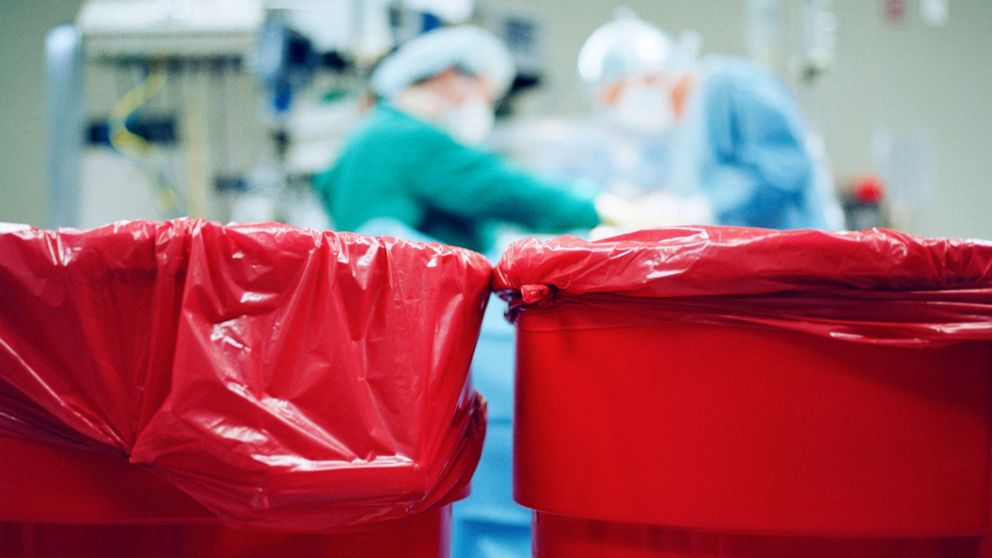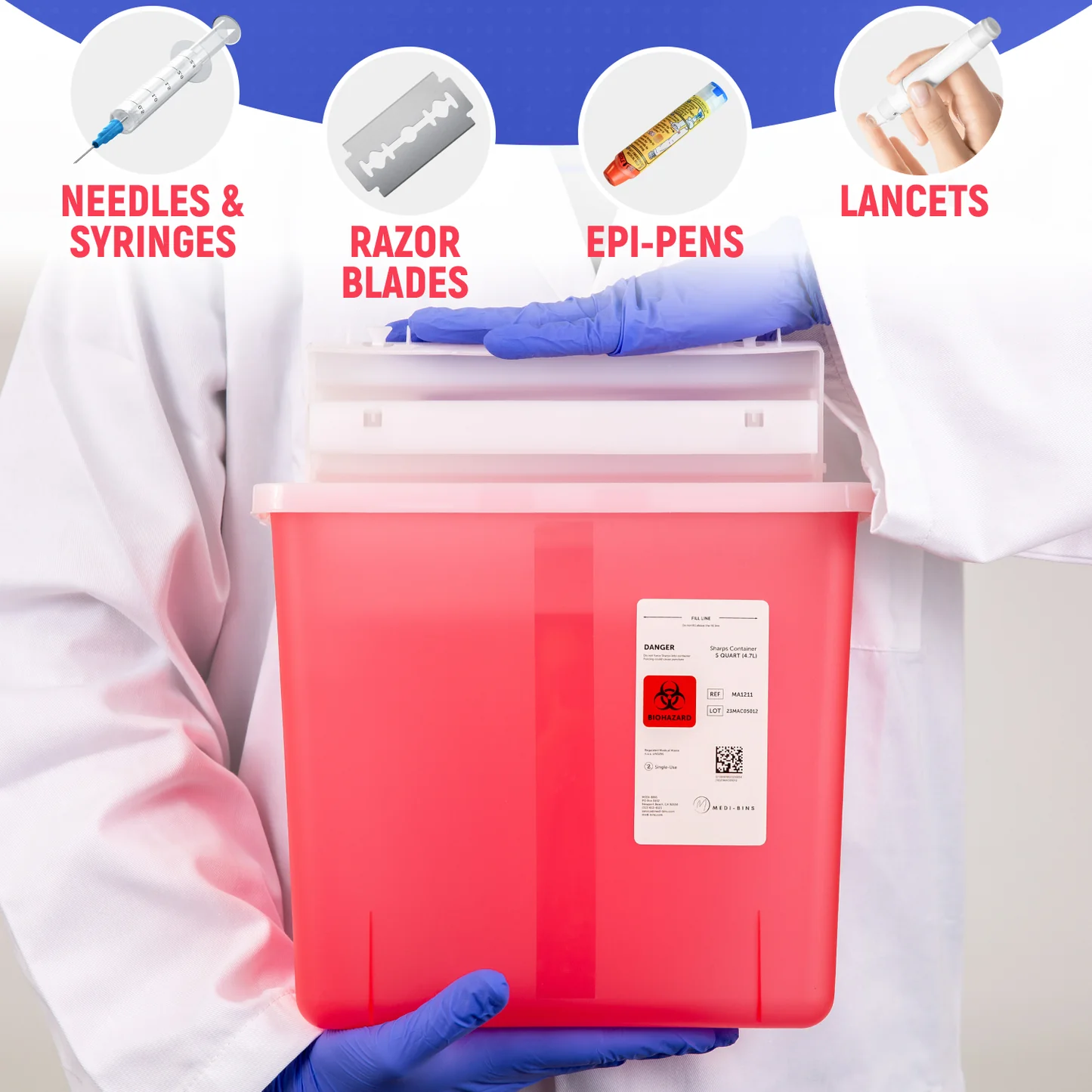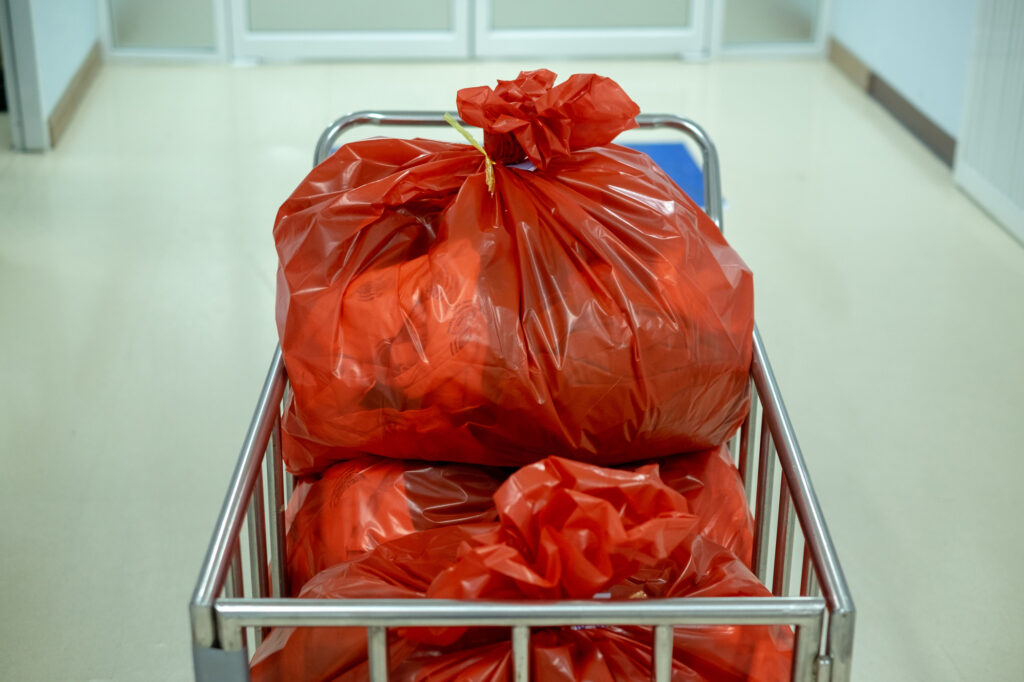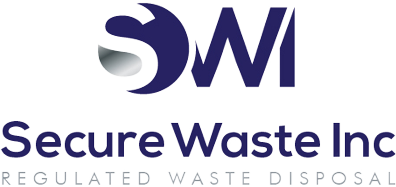Sustainable Medical Waste Disposal & Recycling in Healthcare
Recycling within healthcare facilities presents unique challenges that require balancing environmental responsibility with patient safety and regulatory compliance. While 85% of healthcare waste is non-hazardous and often recyclable according to the World Health Organization, contaminated or regulated materials require special handling that cannot be compromised for the sake of environmental goals. The complexity arises from the diverse waste streams healthcare facilities generate, from administrative offices producing standard recyclables to operating rooms creating contaminated materials that pose infection risks.
For example, clean corrugated cardboard from supply deliveries, office paper from administrative departments, glass containers from beverages, metal cans from cafeterias, and many plastics like water bottles and clean packaging can be recycled into new products, reducing landfill burden and conserving resources. However, items soiled with blood, body fluids, or other potentially infectious materials must go into biohazard bins for proper medical waste disposal, regardless of their recyclable composition. A plastic container that would normally be recyclable becomes regulated medical waste the moment it contacts patient specimens or bodily fluids.
This guide explains how healthcare organizations can implement sustainable waste practices, from clean recycling programs that divert tons of material from landfills to compliant medical waste disposal that protects workers and patients, while ensuring OSHA and HIPAA regulations are met at every stage of the waste management process.
Recyclable vs. Regulated Waste in Healthcare
Healthcare facilities generate both general and hazardous waste in varying proportions depending on their services and patient populations. According to the World Health Organization, about 85% of health-care waste is general, non-hazardous material that is comparable to household waste in composition and risk level, while the remaining 15% is infectious, toxic, radioactive, or otherwise dangerous and requires specialized treatment. This ratio means that most healthcare waste is actually suitable for standard disposal or recycling if properly segregated.
Non-hazardous items include office paper from administrative work, cardboard packaging from supplies and equipment, plastic bottles and containers from beverages and clean products, glass jars and bottles, aluminum cans, and clean plastics from product packaging. These materials can often be diverted from landfills through well-designed recycling programs that treat healthcare facilities like any other commercial building for these waste streams.
Regulated waste, such as sharps contaminated with blood or medications, pathological waste including tissues and organs, pharmaceutical waste containing controlled substances or hazardous drugs, chemotherapy waste requiring special handling, and lab reagents classified as hazardous chemicals, must follow strict medical waste disposal protocols established by federal and state regulations. The consequences of improperly disposing of regulated waste can include disease transmission, environmental contamination, regulatory penalties, and serious harm to waste handlers and the public.
For recyclable items, consistency is key to program success. Many hospitals have dedicated bins strategically placed for cardboard boxes in receiving areas, office paper near copiers and printers, bottles in break rooms and cafeterias, and cans in high-traffic areas. Single-stream recycling, where all recyclables go in one bin, can simplify collection for busy healthcare workers and reduce the number of containers needed, but requires careful sorting later at recycling facilities to separate materials. Alternatively, facilities may pre-sort by material type using multiple bins, which produces cleaner recycling streams but requires more space and more decision-making from staff.
In either case, keeping recyclables clean is essential for the entire program’s viability. Rinse out food containers to remove residue, remove non-recyclable components like plastic lids on paper coffee cups before recycling, and ensure items are dry before placing them in bins. Contaminated recyclables can spoil an entire batch at the recycling facility. For example, a greasy pizza box with food residue stuck to the cardboard usually must be thrown away because the grease contaminates the paper fibers and makes them unsuitable for recycling. Similarly, plastic containers with significant food residue may be rejected by recycling facilities.
Expert Tip:
Post clear signage with images and simple text on recycling stations to help staff quickly identify acceptable materials, especially in high-stress environments where workers need to make quick decisions. Consistent reminders through posters, staff meetings, and ongoing education reduce contamination rates and improve diversion rates, making the program more cost-effective and environmentally beneficial.
Implementing a Sustainable Recycling Program
Building an effective healthcare recycling program starts with comprehensive staff education and thoughtful system design that makes recycling the easy choice. Begin by conducting a waste audit to assess which materials your facility generates in the largest quantities, their current disposal methods, and opportunities for diversion. Common categories include paper and cardboard, various types of plastics identified by resin codes, metals including aluminum and steel, and glass in different colors.
Provide clearly labeled bins for each category with color coding that is consistent throughout the facility. Visual consistency helps staff develop automatic sorting habits. Many hospitals achieve impressive success by placing recycling bins directly next to standard waste bins in break rooms, nursing stations, offices, patient rooms, and clinics. This side-by-side placement makes recycling intuitive and removes the excuse that recycling bins are inconvenient or hard to find. When recycling is as easy as throwing something away, participation rates increase dramatically.
Offering bins for mixed recyclables alongside bins for regular trash reduces the cognitive burden on busy healthcare workers who may not have time to determine which type of plastic or paper category an item belongs to. Clear signage with pictures of acceptable items helps workers make quick, correct decisions even during hectic shifts.
Implementation Checklist:
Set up separate containers for paper and cardboard, plastics marked with recycling symbols, metals including cans and clean foil, glass bottles and jars, and general trash. Ensure containers are appropriately sized for the volume generated in each location.
Place lockable bins or secure containers for any confidential documents to address HIPAA concerns. These locked consoles prevent unauthorized access to protected health information while allowing easy deposit of documents by authorized staff. Partner with certified shredding services that can recycle the shredded paper after destroying PHI.
Ensure sharps containers for needles, scalpels, and other sharps are puncture-resistant, properly labeled with the biohazard symbol, and positioned at point of use. These containers must meet specific regulatory standards and should never be substituted with improvised containers. Replace containers when three-quarters full to prevent overfilling injuries.
Train all staff on what items belong in each bin, with special emphasis on distinguishing clean recyclables from biohazardous waste. Training should be role-specific, recognizing that clinical staff handle different waste than administrative personnel. Provide examples of common items and where they belong, and address frequently asked questions.
Provide hand hygiene stations and PPE such as gloves near disposal areas to comply with OSHA bloodborne pathogen standards and general infection control practices. Even when handling recyclables, healthcare workers may need to protect themselves from residual contamination. Make hand sanitizer and handwashing sinks readily available near waste disposal areas.
Establish a regular review schedule to audit the program’s effectiveness. Assign responsibility for oversight to specific individuals or a sustainability committee. Track metrics like diversion rates, contamination incidents, cost savings, and participation levels to identify trends and opportunities for improvement.
Regularly reviewing and auditing the program is crucial for long-term success and continuous improvement. Check that recyclables are not contaminated with food waste, liquids, or hazardous materials that could render entire loads unrecyclable. In healthcare settings, plastic syringes, medication vials, or specimen containers must go in medical waste, not recycling, even if they appear to be made of recyclable plastic. The contamination risk overrides the material composition. By staying vigilant through spot checks, staff feedback sessions, and periodic waste audits, your team can maximize recycling while maintaining patient and staff safety.
Preventing Contamination & Ensuring Compliance
Minimizing contamination protects both people and budgets while maintaining the integrity of recycling programs. When recyclables become tainted, for instance if a bloody bandage ends up in the paper bin or a used syringe appears in the plastic recycling, the entire load might be rejected by the recycling facility and sent to a landfill instead. This raises disposal costs significantly and defeats the environmental purpose of the recycling program. The cost of disposal for contaminated recycling can exceed regular trash disposal.
Consistent training reinforces the critical rules that prevent contamination: biohazard waste such as soiled dressings, used gloves, culture plates, and anything contaminated with blood or body fluids goes in labeled red bags designated for biohazardous waste, not the blue recycling cart or any other receptacle. The color-coding system should be standardized throughout the facility to prevent confusion when staff move between departments.
OSHA regulations require protecting workers from waste-related hazards through comprehensive safety programs. For example, OSHA’s Bloodborne Pathogens Standard (29 CFR 1910.1030) mandates safe handling of sharps and medical waste to prevent needle-stick injuries that can transmit serious diseases. This standard requires healthcare facilities to implement engineering controls like safety-engineered sharps devices, work practice controls including prohibitions on recapping needles, and use of personal protective equipment by anyone handling potentially infectious waste.
All personnel who handle waste, including housekeeping staff, waste transporters, and clinical workers, must be trained on bloodborne pathogen precautions and wear appropriate personal protective equipment (PPE) such as gloves, and when necessary, gowns, face protection, and shoe covers. Training must be provided at hire, annually thereafter, and whenever procedures change. Safe needle disposal into approved, puncture-resistant sharps containers is non-negotiable under OSHA guidance and represents one of the most critical safety practices in healthcare.
HIPAA adds another crucial layer of complexity to healthcare waste management: patient privacy extends to trash and recycling. Healthcare records, patient identification labels, prescription information, appointment schedules, insurance forms, and other protected health information (PHI) cannot be thrown into unlocked dumpsters or recycling bins accessible to unauthorized individuals. The U.S. Department of Health and Human Services explicitly forbids simply discarding PHI in public waste bins where anyone could retrieve and read sensitive patient information.
Instead, such documents must be shredded using cross-cut shredders or destroyed through pulping, incineration, or other methods so they are unreadable and cannot be reconstructed before disposal. Many facilities use locked consoles positioned in nursing stations and administrative areas where staff can deposit PHI, and then recycle the shredded material after it has been rendered unreadable, or partner with a certified shredding service that provides secure collection, witnessed destruction, and certificates of destruction. These steps ensure HIPAA compliance while incorporating environmentally responsible recycling of the shredded paper.
Benefits of Sustainable Waste Practices
Adopting comprehensive waste segregation and recycling programs offers clear, measurable advantages across environmental, economic, and social dimensions. Environmentally, recycling keeps tons of material out of landfills where it would occupy space and potentially leach contaminants, and out of incinerators where it would generate greenhouse gas emissions. Every ton of recycled material represents natural resources conserved, energy saved in manufacturing, and pollution prevented.
Economically, effective recycling programs can reduce disposal expenses significantly because recycling is often less expensive than landfill disposal or incineration of medical waste. Some recycled materials even generate revenue when sold to recycling processors. A recent survey of 370 U.S. hospitals found they collectively diverted over 264 million pounds of waste from landfills through recycling programs in one year, representing an enormous volume of material given new life instead of being buried or burned.
These efforts not only avoided excessive waste disposal charges but also cut carbon emissions by an estimated 274,000 metric tons, equivalent to removing thousands of cars from the road or planting millions of trees. The environmental impact of these programs extends far beyond the hospital walls. Hospitals participating in the survey saved nearly $200 million through these sustainability initiatives, with savings coming from reduced disposal costs, revenue from recyclable materials, and avoided costs from waste prevention efforts.
More than just impressive statistics, sustainable waste practices foster a culture of responsibility and environmental stewardship in healthcare settings. Staff members and patients alike appreciate a facility’s commitment to environmental protection, and many healthcare workers report higher job satisfaction when working for environmentally responsible organizations. By showing that medical waste disposal can be both safe and sustainable, healthcare organizations strengthen their social responsibility profile, support public health through environmental protection, and align their operations with their healing mission.
This culture of sustainability often extends beyond waste management to influence purchasing decisions, energy use, water conservation, and other environmental aspects of healthcare operations, creating a virtuous cycle of continuous improvement.
Conclusion
In summary, effective healthcare waste management combines smart recycling with strict safety protocols and regulatory compliance. Segregate trash at the source by providing convenient, clearly labeled containers and comprehensive staff training. Keep recyclables clean by rinsing containers and removing non-recyclable components. Treat regulated waste according to OSHA rules and OSHA bloodborne pathogen standards to protect workers from injury and infection. Protect patient data under HIPAA by shredding PHI before disposal or recycling. Partnering with a qualified provider ensures secure waste removal aligned with all federal and state regulations while supporting environmental goals.
Responsible waste management is crucial for healthcare facilities seeking to fulfill their mission of promoting health and healing. To meet OSHA and HIPAA standards while advancing sustainability goals and reducing environmental impact, implement a training-driven recycling program supported by clear procedures and compliant waste disposal strategies. For expert guidance and secure medical waste disposal services tailored to your facility’s unique needs, contact Secure Waste to schedule a consultation and learn how comprehensive waste management can protect people and the planet.

Expert Medical Waste Management: With over 25 years of industry experience, Secure Waste is a trusted local leader in hazardous and biohazardous waste disposal across Maryland, Virginia, and Washington, D.C. Specializing in medical waste management, sharps needle disposal, and biohazard waste removal, the company ensures full compliance with federal, state, and local regulations while prioritizing environmental sustainability.
The company also offers additional services, including secure document shredding and sharps container sales, providing comprehensive solutions for healthcare facilities and businesses. Our cost-effective services help clients maintain regulatory compliance without unexpected costs.
With a commitment to customer satisfaction, Secure Waste offers tailored waste management plans that align with industry best practices. Their team of experts provides reliable, timely, and compliant services, making them the preferred choice for medical waste disposal. For a free waste quote or more information, visit www.securewaste.net






